
Sodium nitrate (NaNO3) structure, properties, uses, risks

The sodium nitrate is a crystalline inorganic solid formed by a sodium ion Na+ and a nitrate ion NO3-. Its chemical formula is NaNO3. In nature it is found as the mineral nitratin or nitratite, which is found in abundance in the Atacama desert in Chile, which is why this mineral is also called Chilean saltpeter or caliche.
Sodium nitrate is a non-combustible solid but it can accelerate the oxidation or burning of flammable materials. For this reason it is widely used in fireworks, explosives, matches, coal bricks, and some types of pesticides, to kill rodents and other small mammals..
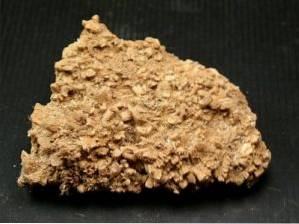
The ability to promote combustion or ignition of other materials means that it must be handled with great caution. If exposed to flames or fire it may explode. Despite this the NaNO3 It is used in the food industry as it has preservative properties, especially for meats and some types of cheeses..
However, its ingestion in excess can cause health problems, especially in pregnant women, babies and children. By transforming into nitrites in the digestive system, it can cause certain diseases.
Article index
- 1 Chemical structure
- 2 Nomenclature
- 3 Properties
- 3.1 Physical state
- 3.2 Molecular weight
- 3.3 Melting point
- 3.4 Boiling point
- 3.5 Density
- 3.6 Solubility
- 3.7 pH
- 3.8 Other properties
- 4 Obtaining
- 4.1 Presence in the human body
- 5 Uses
- 5.1 In the food industry
- 5.2 In fertilizers
- 5.3 As a promoter or facilitator of combustion or explosion
- 5.4 To eliminate rodents and other mammals
- 5.5 In the preparation of other compounds
- 5.6 In the extraction of metals from electronic waste
- 5.7 In health and exercise research
- 5.8 In various uses
- 6 Risks
- 6.1 Dangers of handling
- 6.2 Problems related to its ingestion with food or water
- 7 Sodium nitrate in food
- 8 References
Chemical structure
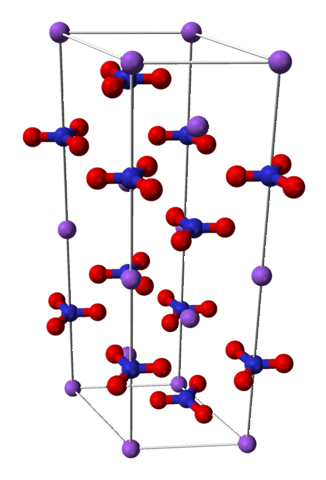
Sodium nitrate is made up of a sodium cation Na+ and a nitrate anion NO3-.
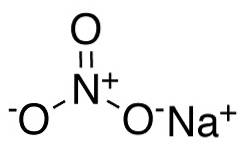
In the nitrate anion NO3- nitrogen N has a valence of +5 and oxygen a valence of -2. For this reason, the nitrate anion has a negative charge..
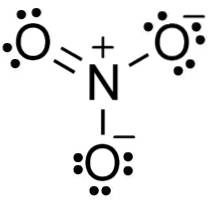
Anion NO3- it has a flat and symmetrical structure, in which the three oxygens distribute the negative charge equally or uniformly.

Nomenclature
-Sodium nitrate
-Sodium nitrate
-Sodium saltpeter (from the English sodium saltpeter)
-Nitro soda (from the English soda nitre)
-Saltpeter of Chile
-Chile nitrate
-Nitratin
-Nitratite
-Caliche
Properties
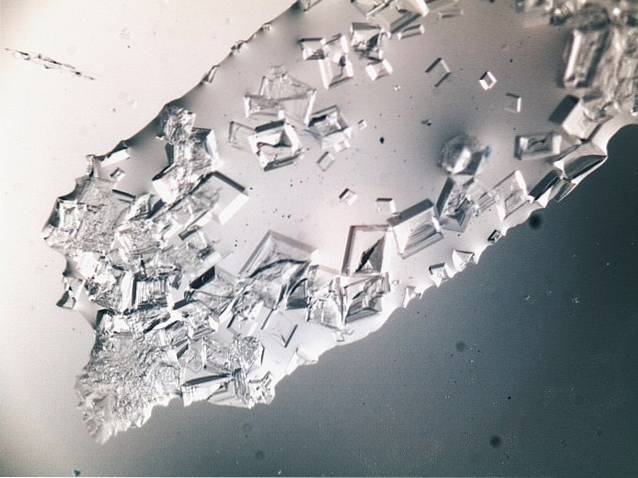
Physical state
Colorless to white solid, trigonal or rhombohedral crystals.
Molecular weight
84.995 g / mol
Melting point
308 ºC
Boiling point
380 ºC (decomposes).
Density
2,257 g / cm3 at 20 ºC.
Solubility
Soluble in water: 91.2 g / 100 g of water at 25 ºC or 1 g in 1.1 mL of water. Slightly soluble in ethanol and methanol.
pH
Sodium nitrate solutions are neutral, that is, neither acidic nor basic, therefore their pH is 7.
Other properties
It is a hygroscopic solid, that is, it absorbs water from the environment.

Its dissolution in water makes the solution cool, so it is said that this dissolution process is endothermic, in other words, when it dissolves it absorbs heat from the environment and that is why the solution cools.
At very low temperatures sodium nitrate is soluble in NH liquid ammonia3, forming NaNO34NH3 below -42 ºC.
Nano3 It is not combustible, but its presence accelerates the combustion of materials or compounds that are. This is because when heated it produces oxygen Otwo, among other gases.
Obtaining
It is obtained mainly by extraction from mineral deposits or saltpeter mines in Chile (caliche or nitratite). For this, brine is used and then crystallization and recrystallization are carried out to obtain NaNO crystals.3 more pure.
These mines are mainly located in South America in the north of Chile in the Atacama desert. There it is associated with potassium nitrate KNO3 and decomposing organic matter.
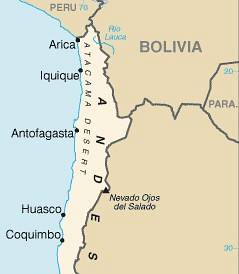
It can also be obtained by reacting nitric acid with sodium carbonate NatwoCO3 or with sodium hydroxide NaOH:
2 HNO3 + NatwoCO3 → 2 NaNO3 + COtwo↑ + HtwoOR
Presence in the human organism
Sodium nitrate can enter the human body through food and drinking water that contains it..
60-80% of ingested nitrate comes from fruits and vegetables. A second source is cured meats. It is used by the meat industry to prevent the growth of microbes and to retain color.
However, a high proportion of nitrate present in the human body comes from its endogenous synthesis or due to processes within the body..
Applications
In the food industry
It is used as a preservative in foods, as a curing agent for pickled meats, and as a color retention agent for meats. Foods that can contain it are bacon, sausages, ham and some cheeses.
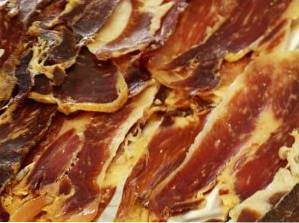
In fertilizers
Sodium nitrate is used in fertilizer mixtures, to fertilize tobacco, cotton and vegetable crops.
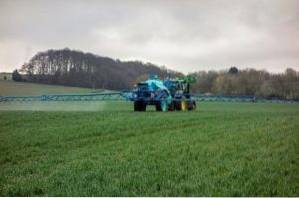
As a promoter or promoter of combustion or explosion
Nano3 it is used as an oxidant in many applications. It is a solid rich in oxygen that facilitates the ignition process by producing Otwo.
The presence of NaNO3 makes materials do not require oxygen from external sources to ignite as it supplies enough Otwo as to self-sustain exothermic (heat generating) reactions that occur during ignition or explosion.
It has long been used as the main oxidant in pyrotechnic materials (fireworks), as an oxidizing component in explosives and detonation or blasting agents, and as a propellant.

It is also used to improve the combustion of coal bricks (briquettes), to favor the lighting in matches and even to improve the combustible properties of tobacco..
To eliminate rodents and other mammals
It is used for a special type of pesticide. The compositions that contain it are pyrotechnic fumigants that are placed and set on fire in burrows, releasing lethal doses of toxic gases.
For this reason, it is used for the control of various rodents, marmots, coyotes, and skunks, in open fields, grasslands, uncultivated areas, lawns, and golf courses..
In the preparation of other compounds
Used in the manufacture of nitric acid HNO3, sodium nitrite NaNOtwo, and also acts as a catalyst in the preparation of sulfuric acid HtwoSW4.
It is used in the manufacture of nitrous oxide NtwoOr and as an oxidizing agent in the manufacture of pharmaceutical compounds.
In the extraction of metals from e-waste
Certain researchers found that NaNO3 facilitates the non-polluting extraction of metals contained in electronic equipment waste (cell phones, tablets, computers, etc.).
Useful metals that can be extracted from the components of these electronic equipment are Nickel Ni, Cobalt Co, Manganese Mn, Zinc Zn, Copper Cu and Aluminum Al.
The extraction is carried out using only a NaNO solution3 and a polymer. And a yield of 60% is achieved.
In this way, electronic waste can be recycled, contributing to the minimization of waste and the stable recovery of resources..
In health and exercise research
According to some studies the ingestion of NaNO supplements3 or foods that contain it naturally have positive effects on health. Some of the foods rich in nitrates are beets, spinach and arugula.
Effects include improving the cardiovascular system, lowering blood pressure, improving blood flow, and increasing the amount of oxygen in tissues that are physically exercising..
This indicates that the use of NaNO could be considered.3 as a low-cost medication in the prevention and treatment of patients with blood pressure problems.
In addition, it can serve as an effective and natural aid to increase muscle power in athletes.
In various uses
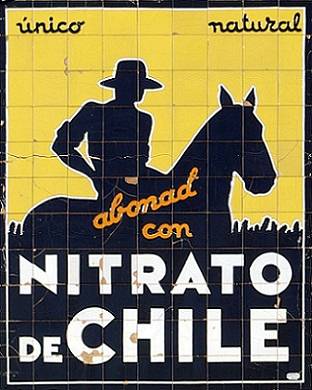
It is used as an oxidant and fluxing agent in the manufacture of glass and ceramic glazes. It is also used in special cements.
Serves as a chemical agent in the recovery of tin from scrap metal, in latex coagulation, in the nuclear industry, and in the control of corrosion in aqueous systems.
Risks
Dangers of handling
It has the property of accelerating the combustion of flammable materials. If you are involved in a fire an explosion may occur.
When exposed to heat or fire for prolonged periods, it can explode, producing toxic nitrogen oxides..
Problems related to its ingestion with food or water
Nitrate when ingested can become nitrite both in the mouth and in the stomach and intestines.
Nitrite, when reacting with the amines present in some foods, can become nitrosamines in an acidic environment such as in the stomach. Nitrosamines are carcinogenic.
However, this does not occur when fruits and vegetables that contain nitrates are eaten naturally..
According to some studies, the presence of high levels of nitrate can produce a blood disorder that makes oxygen cannot be released effectively in the tissues.
This can occur in babies whose milk formula is made from well water that contains nitrates..
It has also been observed that high levels of nitrate can cause problems in the gestation of babies, causing spontaneous abortions, premature births or defects in the neural tube of the fetus.
Recently it has been found that sodium nitrate can pose a risk to the development of the musculoskeletal system and nerve-muscle communication is impaired in humans.
Sodium nitrate in food
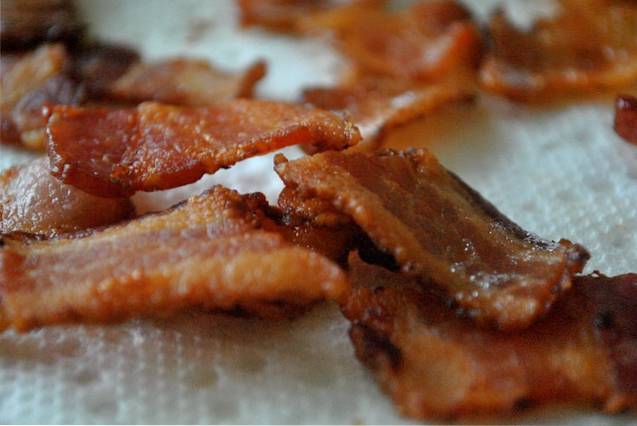
Sodium nitrate is synonymous with meats, because together with nitrite, they are added to them in order to preserve them and improve their appearance and flavors. For its cause, the excessive consumption of meats (hot dogs, bacon, hams, smoked fish, etc.) has been involved in the disturbing link of cancers throughout the digestive system.
Although the relationship between meats treated with nitrate-nitrite salts and cancer is not absolute, it is recommended to moderate your intake.
On the other hand, vegetables (carrots, beets, radishes, lettuce, spinach, etc.) are rich in NaNO3 since they have absorbed it from the cultivation soils due to its fertilizing action. The intake of these vegetables, contrary to meat products, is not linked to the aforementioned diseases.
This is due to two reasons: the difference in the protein levels of such foods, and the way in which they are cooked. When meats are fried or heated on a flame, the reaction between nitrates-nitrites with certain groups of amino acids is promoted, to thus produce nitrosoamines: the true carcinogens.
The content of vitamin C, fiber and polyphenols in vegetables reduces the formation of these nitrosoamines. That is why NaNO3 alone is not a threat to food.
References
- U.S. National Library of Medicine. (2019). Sodium nitrate. Recovered from: pubchem.ncbi.nlm.nih.gov.
- Ullmann's Encyclopedia of Industrial Chemistry. (1990). Fifth Edition. VCH Verlagsgesellschaft mbH.
- Pouretedal, H.R. and Ravanbod, M. (2015). Kinetic study of Mg / NaNO3 pyrotechnic using non-isothermal TG / DSC technique. J Therm Anal Calorim (2015) 119: 2281-2288. Recovered from link.springer.com.
- Jarosz, J. et al. (2016). Sodium nitrate decreases agrin-induced acetylcholine receptor clustering. BMC Pharmacology and Toxicology (2016) 17:20. Recovered from bmcpharmacoltoxicol.biomedcentral.com.
- Cotton, F. Albert and Wilkinson, Geoffrey. (1980). Advanced Inorganic Chemistry. Fourth Edition. John Wiley & Sons.
- Prival, M.J. (2003). Cancer. Carcinogens in the Food Chain. In Encyclopedia of Food Sciences and Nutrition (Second Edition). Recovered from sciencedirect.com.
- Zakhodyaeva, Y.A. et al. (2019). Complex Extraction of Metals in an Aqueous Two-Phase System Based on Poly (Ethylene Oxide) 1500 and Sodium Nitrate. Molecules 2019, 24, 4078. Recovered from mdpi.com.
- Clements, W.T. et al. (2014). Nitrate Ingestion: A Review of the Health and Physical Performance Effects. Nutrients 2014, 6, 5224-5264. Recovered from mdpi.com.
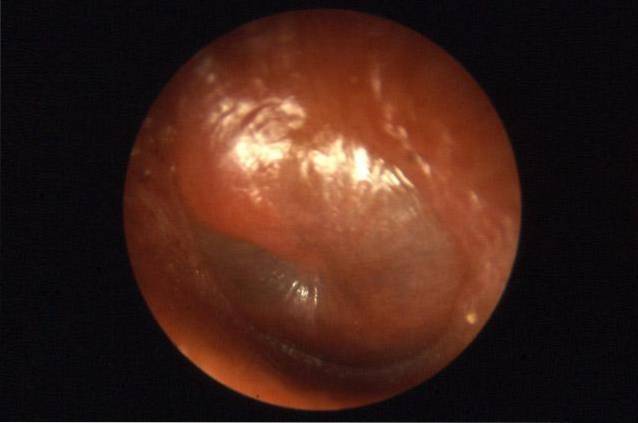


Yet No Comments